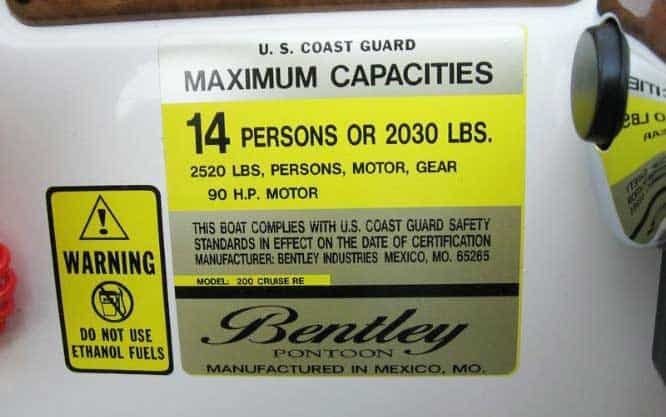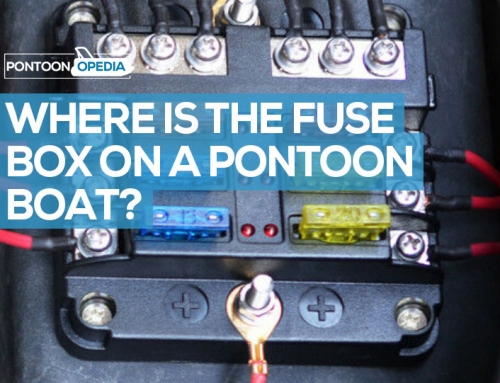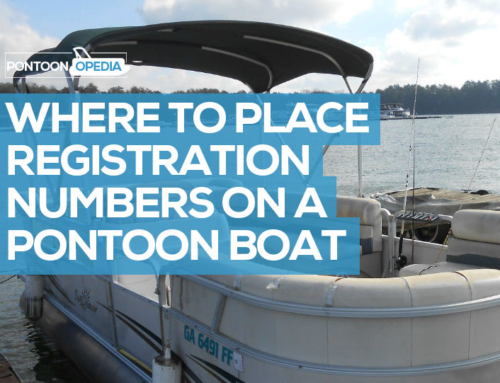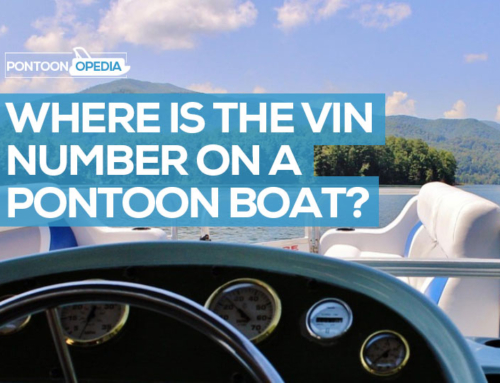You’ve bought your new pontoon boat, summer is fast approaching, and you’re sending those invites out to all your buddies and family members… but wait. Just how many people can you fit onto your pontoon boat?
Whilst it might be tempting to cram as many of your friends and family on board as you possibly can, after all, you’ve got a new boat to show off, just slow down a little. There’s some essential information you need to know before getting people aboard.
The most important aspect of all is safety, followed by legality.
If you over-load your boat with weight, you could seriously endanger lives. You will also attract the attention of the US Coast Guard.
Now thankfully, most pontoon boats will have a capacity plate sticker somewhere on board. It’s a legal requirement in the United States and should be in clear view of the helm. Take a look around and see if you can see yours.
It should look a little bit like this in the photo below.

This is what a boat capacity decal, plate, or sticker looks like. Notice the top part about 14 persons.
Handy Hint: If your pontoon boat doesn’t have capacity plate on it, you can get replacements. Click here to find out how.
Did you notice what it said on the capacity plate above?
There’s a piece of text on the sticker which states how many people you can safely take on your boat. Not just as a number, but also as a maximum weight limit.
That should be the first place you look if you want to know how many people and passengers can come on-board.
But what if you are planning on hiring a pontoon boat, or are thinking about buying one? How will you know without seeing the capacity plate? You can find out below.
Table of Contents
How to Calculate the Amount of People You Can Carry
If you don’t have access to the capacity plate, then you can still get a reasonably good idea on how many people you can fit and carry on the boat.
The design of a pontoon, which some people liken to that of a patio on tubes, means you have a larger deck space. It’s much larger than a v-shaped hull which you get on powerboats, meaning pontoon boat owners can fit more people on-board.
Pontoon boats tend to come in standard sizes.
One of the leading and best-known manufacturers is a company called Bennington (visit website). On their website they list out some guidelines as to how many passengers their standard sized pontoons can carry safely. You can see those guidelines below.
- 17 to 19 Foot Pontoon – Up to 8 passengers / people
- 20 to 22 Foot Pontoon – Up to 13 passengers / people
- 23 to 28 Foot Pontoon – Up to 15 passengers / people
I would say that the numbers above provide some very good guidance, not just for the Bennington range of pontoons, but also for other brands as well.
But what if you have something a little bit different?
It might be a tritoon with three tubes, or a double-decker. If you’re going to be on the water in either of those types of boat, look up the specification online for the exact brand and model, as it will vary wildly as to how many people you can fit on.
When you phone up or email the manufacturer of the pontoon, they are always more than happy to help you out if the information isn’t easily accessible via their websites.
Try My Pontoon Weight Capacity Calculator
I have also spent a lot of time developing a bespoke pontoon boat weight capacity calculator. Go take a look at it. What it does is let you type in the dimensions of your tubes and logs, to then produce a rough calculation on how much weight your boat can carry safely.
Bear in mind, it is for illustrative purposes only, and should be used as a guide. I always recommend you talk with the manufacturer of the pontoon boat if you are not sure on how many people you can fit on yours.
Do Your Own Calculations
There is also another method which is commonly used in pontooning circles, which requires you doing a little bit of the math yourself. It’s based on how the US Coast Guard provide the calculations that appear on the capacity plates, and goes something like this:
How Many People on a Pontoon? (Boat’s Length × Width) / 15 = Number of Passengers
Again, please don’t take this calculation as gospel. You need an official figure to keep legal and safe, which you can only get from the capacity plate, or from the boat manufacturer.
What Happens if You Overload a Pontoon Boat?
The effects of having too many people on your pontoon boat are wide-ranging. Below I’ve listed and go into some more detail on what could happen, and how you day on the water may be negatively impacted.
Capsizing Risks
As I mentioned earlier, exceeding your passenger limit on a pontoon boat can lead to severe consequences, which will typically result from a capsize. Whilst pontoons very rarely sink and are built to float, capsizing is a risk when there are too many people aboard.
If you’re boating in rough conditions such as choppy water, then these risks are magnified ten-fold. It’s simply not worth the risk.
Legal Issues
You must never overload your pontoon with too many passengers and are required by law to adhere to the capacity plate instructions. The details on passenger loads printed on the labels are a result of the manufacturer tests, and government legislation.
There could be some differences in the law depending on what state you live in (click here to see state laws), but overall, don’t disobey the capacity plate sticker. It’s there for a good reason.
I’ve personally seen the coast guard pull over-loaded pontoons back to shore and slap the captain with a fine. You could even risk a jail sentence if someone is injured due to over-loading, with a worst-case scenario leading to death.
Insurance Invalidation
I assume that you already have insurance for your pontoon boat. You would be crazy not to.
Regardless, let’s pretend for a moment that you do have an accident, and it’s found that you had too many people on-board. When it comes to making an insurance claim, either for, or against you, you’re going to be in a whole load of trouble.
Why? Because your insurance coverage and policy will be completely invalid due to you exceeding how many passengers you had on the pontoon. It’s simply not worth the risk in carry more passengers than you are permitted to.
Reduced Performance
In addition to the legal and safety ramifications, you’re also going to dramatically reduce the performance of your pontoon if it has too many people on deck.
I’ve previously spoken at length on Pontoonopedia about how reducing your passengers can lead to faster speeds.
The thing is, pontoon boats aren’t really designed for pulling tubes and skiers. Yes, they do a very good job if you have enough horsepower, but the more people aboard, the slower you are going to go.
If water skiing and inflatable tubing is important to you, and it’s how you are planning your next trip, you need to keep the passenger numbers down. What I do when pulling is drop off everyone else at the shore, and just have me and a spotter (legally required) on the boat who is at the rear, keeping an eye on the people being pulled.
As well as pulling speeds, you will also find it hard to manoeuvre your pontoon in the water even if you aren’t partaking in water sports. I can only compare it to over-loading a trailer with rubble; you can visualize how that would affect your turning and manoeuvrability on the roads and it’s the same with a pontoon boat.
How to Deal with Too Much Weight
By now you should have a decent idea on how many people can fit on your pontoon boat. However, if you do get right up to the maximum limit there are some things you can do to make things as safe as possible, and to improve the performance which I’ve already touched on slightly.
I’ve already given you the first tip, which is to drop people at shore if you want more pulling power when pulling tubes and skiers.
But what about if you want to party out on the water and don’t want to drop people off?
As long as you are not exceeding the passenger limit, you can get the people to shift their weight around. It’s a simple method of weight distribution where you should ensure that passengers are evenly spaced around the boat.
By doing so, you should get a smoother ride across the water and will be able to turn and manoeuvre a lot easier.
If you are finding that your pontoon continues to struggle when you have the maximum amount of people on-board, you might want to consider a longer-term solution.
That involves converting the pontoon to a tritoon. Tritoons are the same as pontoon boats, but with one key difference; the addition of a third tube. This increases your boat’s weight capacity, stability, and speed performance. You can find out more on how pontoons and tritoons differ elsewhere on Pontoonopedia.
It will cost you a few thousand dollars to have a third pontoon log added to your boat, so many people actually end up trading in their older boat for a tritoon.
Enhanced Safety Measures for Optimal Pontoon Boat Capacity
The capacity plate on a pontoon boat offers valuable information regarding the maximum passenger limit. However, to ensure safety, it’s crucial to consider other factors like weather conditions, operator experience, and weight distribution.
- Weather Conditions: High winds, rough seas, or storms can jeopardize a pontoon boat’s stability and handling. Reducing passenger numbers in adverse conditions ensures safety by allowing easier control and minimizing the risk of accidents.
- Operator Experience: A boat operator’s experience is vital for maintaining safety. Inexperienced operators might struggle with a fully-loaded boat in difficult conditions or crowded areas. Limiting the number of passengers can help the operator retain control and avert hazards.
- Proper Weight Distribution: Distributing weight evenly is critical for maintaining stability and avoiding an unbalanced vessel. When determining a safe passenger count, consider the distribution of passengers, equipment, and supplies. Overloading one area can jeopardize stability and heighten accident risk.
- Emergency Preparedness: In emergencies, a crowded pontoon boat can hinder quick and safe evacuation. When determining maximum capacity, consider ease of movement and accessibility of life jackets and other safety gear.
Conclusion
Please don’t overload your pontoon boat with too many passengers. Knowing how many people can fit on your boat is your responsibility and the captain and owner.
Most of the time, it just comes down to common sense. If it doesn’t look and feel safe, then it probably isn’t.
I would also recommend that you check over this list of pontoon boat safety equipment to make sure you have everything required by law to be on the water at all times.






